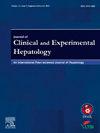评估肝移植受者社会心理影响的创新方法:逐项预测分析法
IF 3.3
Q2 GASTROENTEROLOGY & HEPATOLOGY
Journal of Clinical and Experimental Hepatology
Pub Date : 2024-09-25
DOI:10.1016/j.jceh.2024.102418
引用次数: 0
摘要
背景对肝移植(LT)受者的心理功能采用了创新的分析技术,以了解其对移植后存活率的影响,并假设社会心理功能可预测依从性。此外,还使用药物水平变异指数(MLVI)和活组织检查证实的排斥反应来评估成功的依从性。我们使用 SIPAT 分数的 Z 值将其转化为一个序数变量,分为优、良、可接受和差四个等级。我们采用改良版的对应分析法,以序数 MLVI 类别为预测因子,预测二元 MLVI 和拒绝(表示坚持治疗的成功或失败)。结果LT 受益人的 SIPAT 优秀类别与坚持治疗密切相关,而 SIPAT 最低可接受类别与坚持治疗失败密切相关。女性、19-50 岁和 67-74 岁与依从性相关(r = 0.49-1.00),而男性和 56-60 岁与依从性失败相关(r = 0.43-0.91)。 结论讨论了本研究中引入的新分析方法的临床意义和实用性。本文章由计算机程序翻译,如有差异,请以英文原文为准。
An Innovative Approach to Assessing the Psychosocial Impacts on Liver Transplant Recipients: The Prediction-by-correspondence Analysis
Background
Innovative analytic techniques are applied to the psychological functioning of liver transplant (LT) recipients to comprehend its effect on post-transplant survival, hypothesizing that adherence will be predicted by psychosocial functioning.
Methods
The psychosocial functioning of 248 LT recipients (88 females) aged 19 to 74 is assessed using the Stanford Integrated Psychosocial Assessment for Transplantation (SIPAT). In addition, the Medication Level Variability Index (MLVI) and biopsy-proven rejection are utilized to evaluate successful adherence. The Z-scores of the SIPAT scores are used to transform them into an ordinal variable with excellent, good, minimally acceptable, and poor categories. We employ a modified version of correspondence analysis to predict the binary MLVI and rejection, which signify either success or failure in adherence, using ordinal MLVI categories as predictors.
Results
The excellent SIPAT category for LT beneficiaries was strongly related to adherence, whereas the minimally acceptable SIPAT was strongly related with failure in adherence. Females, ages 19–50, and ages 67–74 were associated with adherence (r = 0.49–1.00), whereas males and ages 56–60 were associated with failure in adherence (r = 0.43–0.91)
Conclusion
The clinical implications and utility of the novel analytic approaches introduced in the study are discussed.
求助全文
通过发布文献求助,成功后即可免费获取论文全文。
去求助
来源期刊

Journal of Clinical and Experimental Hepatology
GASTROENTEROLOGY & HEPATOLOGY-
CiteScore
4.90
自引率
16.70%
发文量
537
审稿时长
64 days
 求助内容:
求助内容: 应助结果提醒方式:
应助结果提醒方式:


